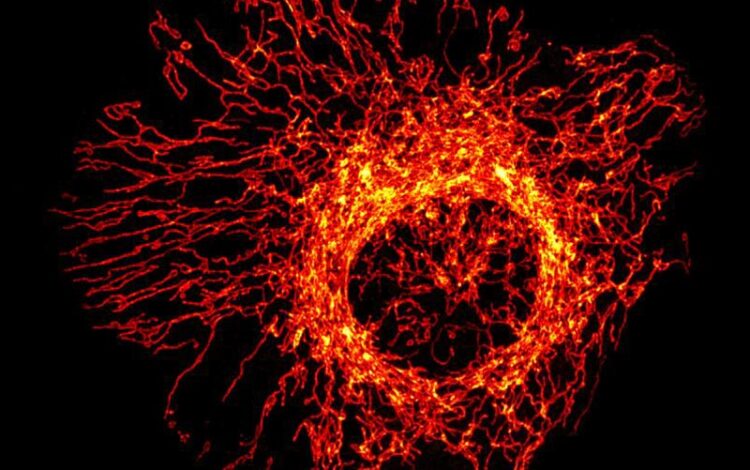Energy supply in human cells is subject to quality control

Mitochondrial network in a cell.
Credit: UMG/MPI/nh
Researchers at the University Medical Center Göttingen (UMG) have discovered a new quality control mechanism that regulates the energy production in human cells. This process takes place in mitochondria, the power plants of the cell. Malfunctions of mitochondria lead to serious diseases of the nerves, the muscles and the heart. The findings could contribute to the development of new therapies for affected patients. The results have been published in the renowned Molecular Cell journal.
(umg) Mitochondria are the power plants of the cell and play a central role for cellular metabolism. therefore malfunctions of the mitochondria lead to serious, often fatal, heart, muscle or nerve diseases. Mitochondria are surrounded by two membranes, an outer and an inner one, which separate them from the surrounding cell. The final conversion of food into energy takes place in the inner membrane. Proteins are involved in this process. Central proteins for energy production are formed in the mitochondria, transported to the inner membrane and inserted there. The protein OXA1L is mainly responsible for the insertion of proteins into the membrane, where larger complex structures are formed with other proteins that interact with each other and ensure energy production. How the incorporation and assembly of these structures works in detail was poorly investigated so far.

Prof. Dr. Peter Rehling, Director of the Department of Cellular Biochemistry at the University Medical Center Göttingen, UMG. umg/spförtner
Scientists led by Prof. Dr. Peter Rehling, Director of the Department of Cellular Biochemistry at the University Medical Center Göttingen (UMG) and member of the Cluster of Excellence “Multiscale Bioimaging: from Molecular Machines to Networks of Excitable Cells” (MBExC), have now discovered that the process of energy production depends on the interaction of the protein OXA1L with the protein TMEM126A. If TMEM126A is missing, a quality control mechanism is activated in the inner membrane of the mitochondria, which ensures that OXA1L and proteins newly generated for the energy production machinery are degraded and thus cannot be incorporated into the membrane. This shows that the protein TMEM126A is critical for energy production in mitochondria. “This finding is an important step in the search for new therapeutic approaches for affected patients. Understanding how proteins interact with each other in mitochondria could help to identify the causes of certain diseases. If we know what is missing in the cell or which process is not working properly in certain diseases, we can develop treatment measures to ‘repair’ this defect,” says Prof. Rehling.
Wissenschaftliche Ansprechpartner:
University Medical Center Göttingen, Georg-August-University
Department of Cellular Biochemistry
Humboldtallee 23, 37073 Göttingen
Prof. Dr. Peter Rehling
peter.rehling@medizin.uni-goettingen.de
Secretariat:
Phone +49 551 / 39-65947
eva.ausmeier@med.uni-goettingen.de
https://biochemie.uni-goettingen.de/
Originalpublikation:
Sabine Poerschke, Silke Oeljeklaus, Luis Daniel Cruz-Zaragoza, Alexander Schenzielorz, Drishan Dahal, Hauke Sven Hillen, Hirak Das, Laura Sophie Kremer, Anusha Valpadashi, Mirjam Breuer, Johannes Sattmann, Ricarda Richter-Dennerlein, Bettina Warscheid, Sven Dennerlein, Peter Rehling. Identification of TMEM126A as OXA1L-interacting protein reveals cotranslational quality control in mitochondria. Molecular Cell (2023). DOI: 10.1016/j.molcel.2023.12.013
Media Contact
All latest news from the category: Life Sciences and Chemistry
Articles and reports from the Life Sciences and chemistry area deal with applied and basic research into modern biology, chemistry and human medicine.
Valuable information can be found on a range of life sciences fields including bacteriology, biochemistry, bionics, bioinformatics, biophysics, biotechnology, genetics, geobotany, human biology, marine biology, microbiology, molecular biology, cellular biology, zoology, bioinorganic chemistry, microchemistry and environmental chemistry.
Newest articles

First-of-its-kind study uses remote sensing to monitor plastic debris in rivers and lakes
Remote sensing creates a cost-effective solution to monitoring plastic pollution. A first-of-its-kind study from researchers at the University of Minnesota Twin Cities shows how remote sensing can help monitor and…

Laser-based artificial neuron mimics nerve cell functions at lightning speed
With a processing speed a billion times faster than nature, chip-based laser neuron could help advance AI tasks such as pattern recognition and sequence prediction. Researchers have developed a laser-based…

Optimising the processing of plastic waste
Just one look in the yellow bin reveals a colourful jumble of different types of plastic. However, the purer and more uniform plastic waste is, the easier it is to…



